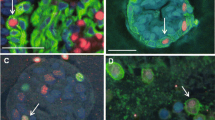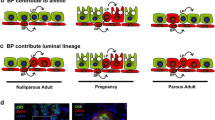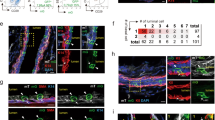Abstract
Background: Long-lived somatic cells such as stem/progenitor cells may progressively accumulate oncogenic mutations and cause cancer. Some evidence suggests that pre-menopausal administration of progesterone confers a long-term increased risk of breast cancer. Aim: To clarify the effect of progesterone on long-lived mammary epithelial cells in rats. Materials and methods: Female Sprague-Dawley rats (3 and 7 weeks of age) were implanted sc with 14-day slow-release pellets of 5-bromo-2′-deoxyuridine (BrdU) and were sacrificed every 2 weeks between 0 and 10 weeks after the release period. Some rats at 7 weeks of age were also implanted with progesterone and sacrificed 0 or 10 weeks after the release period. Mammary glands were examined by immunohistochemistry and immunofluorescence for BrdU, proliferative cell nuclear antigen (PCNA) and progesterone receptor (PR). Results: After BrdU labeling of 3- and 7-week-old rats, the BrdU index decreased gradually over 10 weeks and resulted in small fractions (1–3%) of label-retaining epithelial cells (LREC) 10 weeks after BrdU labeling in both mammary lobules and ducts. Treatment with progesterone during labeling significantly increased the fraction of long-lived LREC in lobules and ducts by 9- and 4-fold, respectively. The long-lived LREC population in the ducts was enriched for PCNA- and PR-positive cells, but the percentage of positive cells was not affected by progesterone in either lobules or ducts. Conclusions: Progesterone stimulates proliferation of a long-lived epithelial cell population in the mammary lobules and ducts of rats. Such cells in the duct are characterized by a high proliferation rate and PR expression.
Similar content being viewed by others
References
Visvader JE. Cells of origin in cancer. Nature 2011, 469: 314–22.
Booth BW, Smith GH. Estrogen receptor-alpha and progesterone receptor are expressed in label-retaining mammary epithelial cells that divide asymmetrically and retain their template DNA strands. Breast Cancer Res 2006, 8: R49.
Smith GH. Label-retaining epithelial cells in mouse mammary gland divide asymmetrically and retain their template DNA strands. Development 2005, 132: 681–7.
Fernandez-Gonzalez R, Illa-Bochaca I, Welm BE, et al. Mapping mammary gland architecture using multi-scale in situ analysis. Integr Biol (Camb) 2009, 1: 80–9.
Welm BE, Tepera SB, Venezia T, Graubert TA, Rosen JM, Goodell MA. Sca-1(pos) cells in the mouse mammary gland represent an enriched progenitor cell population. Dev Biol 2002, 245: 42–56.
Asselin-Labat ML, Sutherland KD, Barker H, et al. Gata-3 is an essential regulator of mammary-gland morphogenesis and luminal-cell differentiation. Nat Cell Biol 2007, 9: 201–9.
Shackleton M, Vaillant F, Simpson KJ, et al. Generation of a functional mammary gland from a single stem cell. Nature 2006, 439: 84–8.
Stingl J, Eirew P, Ricketson I, et al. Purification and unique properties of mammary epithelial stem cells. Nature 2006, 439: 993–7.
Anderson E. The role of oestrogen and progesterone receptors in human mammary development and tumorigenesis. Breast Cancer Res 2002, 4: 197–201.
Beleut M, Rajaram RD, Caikovski M, et al. Two distinct mechanisms underlie progesterone-induced proliferation in the mammary gland. Proc Natl Acad Sci U S A 2010, 107: 2989–94.
Asselin-Labat ML, Vaillant F, Sheridan JM, et al. Control of mammary stem cell function by steroid hormone signalling. Nature 2010, 465: 798–802.
Joshi PA, Jackson HW, Beristain AG, et al. Progesterone induces adult mammary stem cell expansion. Nature 2010, 465: 803–7.
Colditz GA. Estrogen, estrogen plus progestin therapy, and risk of breast cancer. Clin Cancer Res 2005, 11: 909s–17s.
Horwitz KB. The Year in Basic Science: update of estrogen plus progestin therapy for menopausal hormone replacement implicating stem cells in the increased breast cancer risk. Mol Endocrinol 2008, 22: 2743–50.
Cirpan T, Iscan O, Terek MC, et al. Proliferative effects of different hormone regimens on mammary glands in ovariectomized rats. Eur J Gynaecol Oncol 2006, 27: 256–61.
Fabre A, Fournier A, Mesrine S, et al. Oral progestagens before menopause and breast cancer risk. Br J Cancer 2007, 96: 841–4.
Fabre A, Fournier A, Mesrine S, et al. Progestagens use before menopause and breast cancer risk according to histology and hormone receptors. Cancer Epidemiol Biomarkers Prev 2008, 17: 2723–8.
Aldaz CM, Liao QY, LaBate M, Johnston DA. Medroxyprogesterone acetate accelerates the development and increases the incidence of mouse mammary tumors induced by dimethylbenzanthracene. Carcinogenesis 1996, 17: 2069–72.
Gould MN. Rodent models for the study of etiology, prevention and treatment of breast cancer. Semin Cancer Biol 1995, 6: 147–52.
Medina D, Thompson HJ. A comparison of the salient features of mouse, rat, and human mammary tumorigenesis. In: Ip MM, Asch BB, eds. Methods in Mammary Gland Biology and Breast Cancer Research. New York: Kluwer Academic/Plenum Publishers. 2000, 31–6.
Nandi S, Guzman RC, Yang J. Hormones and mammary carcinogenesis in mice, rats, and humans: a unifying hypothesis. Proc Natl Acad Sci U S A 1995, 92: 3650–7.
Imaoka T, Nishimura M, Iizuka D, et al. Radiation-induced mammary carcinogenesis in rodent models: what’s different from chemical carcinogenesis? J Radiat Res (Tokyo) 2009, 50: 281–93.
Russo J, Wilgus G, Russo IH. Susceptibility of the mammary gland to carcinogenesis: I Differentiation of the mammary gland as determinant of tumor incidence and type of lesion. Am J Pathol 1979, 96: 721–36.
Clifton KH. Thyroid and mammary radiobiology: radiogenic damage to glandular tissue. Br J Cancer Suppl 1986, 7: 237–50.
Kamiya K, Clifton KH, Gould MN, Yokoro K. Control of ductal vs. alveolar differentiation of mammary clonogens and susceptibility to radiation-induced mammary cancer. J Radiat Res 1991, 32(Suppl 2): 181–94.
Gould MN, Biel WF, Clifton KH. Morphological and quantitative studies of gland formation from inocula of monodispersed rat mammary cells. Exp Cell Res 1977, 107: 405–16.
Storment JM, Meyer M, Osol G. Estrogen augments the vasodilatory effects of vascular endothelial growth factor in the uterine circulation of the rat. Am J Obstet Gynecol 2000, 183: 449–53.
Freeman ML, Saed GM, Diamond MP. Hormone-independent ovarian influence on adhesion development. Fertil Steril 2002, 78: 340–6.
Potten CS, Hume WJ, Reid P, Cairns J. The segregation of DNA in epithelial stem cells. Cell 1978, 15: 899–906.
Asselin-Labat ML, Shackleton M, Stingl J, et al. Steroid hormone receptor status of mouse mammary stem cells. J Natl Cancer Inst 2006, 98: 1011–4.
Sleeman KE, Kendrick H, Robertson D, Isacke CM, Ashworth A, Smalley MJ. Dissociation of estrogen receptor expression and in vivo stem cell activity in the mammary gland. J Cell Biol 2007, 176: 19–26.
Chepko G, Smith GH. Three division-competent, structurally-distinct cell populations contribute to murine mammary epithelial renewal. Tissue Cell 1997, 29: 239–53.
Clarke RB. Steroid receptors and proliferation in the human breast. Steroids 2003, 68: 789–94.
Graham JD, Mote PA, Salagame U, et al. DNA replication licensing and progenitor numbers are increased by progesterone in normal human breast. Endocrinology 2009, 150: 3318–26.
Schedin P, Mitrenga T, Kaeck M. Estrous cycle regulation of mammary epithelial cell proliferation, differentiation, and death in the Sprague-Dawley rat: a model for investigating the role of estrous cycling in mammary carcinogenesis. J Mammary Gland Biol Neoplasia 2000, 5: 211–25.
Smith GH. Experimental mammary epithelial morphogenesis in an in vivo model: evidence for distinct cellular progenitors of the ductal and lobular phenotype. Breast Cancer Res Treat 1996, 39: 21–31.
Author information
Authors and Affiliations
Corresponding author
Rights and permissions
About this article
Cite this article
Imaoka, T., Hisatsune, H., Sakanishi, Y. et al. Progesterone stimulates proliferation of a long-lived epithelial cell population in rat mammary gland. J Endocrinol Invest 35, 828–834 (2012). https://doi.org/10.3275/8189
Accepted:
Published:
Issue Date:
DOI: https://doi.org/10.3275/8189




